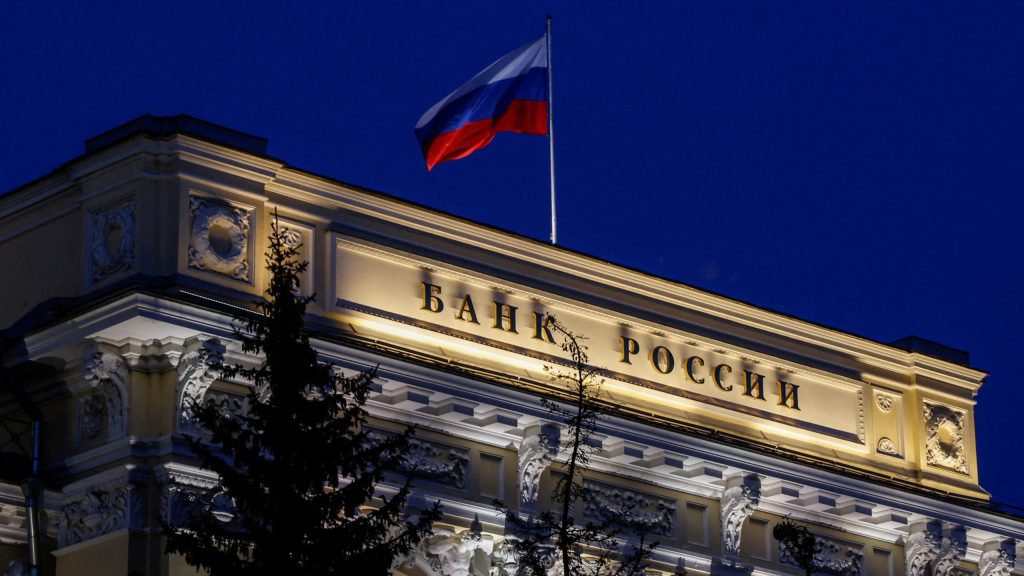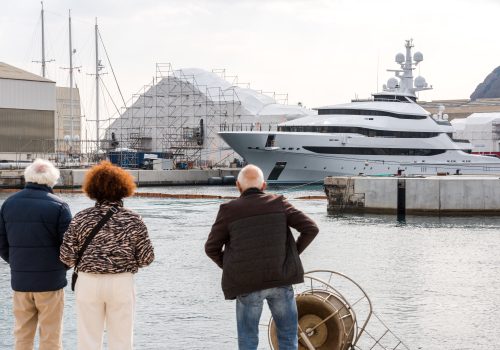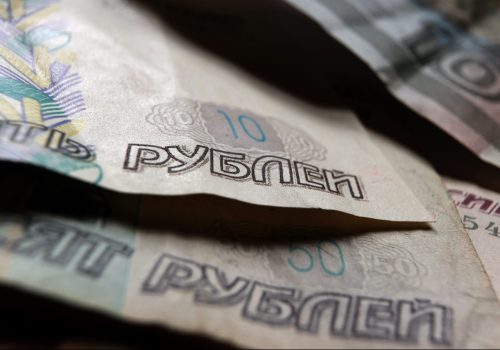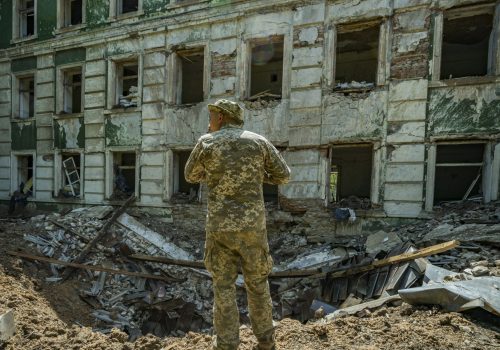Sticking to US President Joe Biden’s public pledge to “stay the course,” the White House has made clear both publicly and privately that it intends to sustain and even intensify its support for Ukraine and pressure on Russia. While military support remains the critical pillar of Western policy, especially in the short term, economic pressure is key to the longer-term goal of isolating Russian President Vladimir Putin.
The challenge facing Ukraine and its partners is the disconnect between the West’s powerful long-term sanctions and the shorter-term military advantages Russia still enjoys despite Western arms shipments to Kyiv. The US and European counterplay, therefore, is to ramp up economic pressure on Russia while helping Ukraine thwart a decisive, near-term Russian military victory. Doing so could induce Putin to settle on terms more favorable to Ukraine, rather than negotiating with him while he controls massive amounts of Ukraine’s territory.
When it comes to economic pressure, the United States and Europe still have plenty of options. The next platform for announcing new measures may come at the Group of Seven (G7) summit this weekend. In our view, there are two key areas that ministers are likely to focus on during (and probably after) the meeting: decreasing Russian revenue from energy sales and using frozen Russian assets for Ukrainian reconstruction. But there are many more options, and we expect discussions will include how to leverage them as part of a shift to a longer-term pressure campaign against Putin and his regime.
Targeting Russian oil revenue
Following the money is usually a good practice when considering options for economic pressure. Oil remains Russia’s number-one export, and the steep rise of global oil prices has meant that Russian income from oil sales has grown despite Russian crude selling at a discount and at lower volumes. Recognizing this, after weeks of difficult debate, the European Union (EU) in early June banned imports of Russian seaborne oil and oil products by roughly year’s end (with exceptions for piped oil and various carveouts for more vulnerable EU members). Given Polish and German decisions to end their own purchases of Russian oil altogether, the EU estimates this partial ban will affect 90 percent of the EU’s imports of Russian oil and oil products by year end. This is a qualified but major step: In 2021, with prices significantly lower, the EU imported 71 billion euros’ worth of Russian oil products.
The United States should back up existing US and EU oil sanctions, acting on its own or in parallel with the EU and United Kingdom, to target revenues through third-country purchases. The challenge facing Western policymakers is how to reduce Russian energy revenues without causing major economic harm globally. With energy prices at near-record highs and inflation at its highest point in decades, this is a tall order. Still, there are three options policymakers should consider:
- As our former US government colleague Eddie Fishman has suggested, imposing a low price cap on Russian oil purchases of thirty or fifty dollars per barrel is one possibility. This could be done by effectively forming a purchasing cartel and threatening secondary sanctions on any purchasers paying above that cap. The goal of this approach would be to keep Russian supply available in a tight market while providing inducement for potential sanctions spoilers—primarily China and India—to accede to US demands by pushing them (through the threat of sanctions) to purchase Russian oil only if it is steeply discounted. But there are substantial downside risks, given that such a mechanism would prove difficult to enforce. New measures would bring uncertainty to an already razor-thin market and could spike prices even without intending to take Russian supply off the table. Another complicating factor in implementing a price cap is whether the EU would need to renegotiate its already-agreed partial oil import ban, which could open the door for leaders friendlier with Moscow to scuttle any action against the Kremlin’s chief revenue stream.
- Another approach floated in the EU is the imposition of a massive tariff on Russian oil and gas purchases. This is based on the theory that Russia would be forced to eat the majority of the tariff—and thereby derive less revenue—because it would be high enough (70 percent, for example) that it would cause European nations to turn to alternative sources of oil if Russia tries to pass the cost on to consumers. But that thesis does not hold in the current environment, and may well not even be viable in a softer market.
- A third alternative would be to use the imposition of targeted sanctions to prevent Russia from converting oil revenues in less liquid foreign currency (such as the Chinese yuan, Turkish lira, and Indian rupee) to more useful Western currencies (such as the US dollar, British pound sterling, Japanese yen, and euro). This could be accomplished via more traditional sanctions on the Russian entities involved in oil sales, including Gazprombank. There would be no need for further restrictions on Russian supply or new market mechanisms, and Russia would be free to export to third countries. Russia may gain wealth on paper, but it would be unable to use those exports to prop up the ruble—as it currently does via forced conversions from those Western currencies—or import additional goods from countries with which it already runs trade surpluses, among other downsides. This approach also risks boosting energy prices if the market fears Russia will voluntarily cease exports, or if rerouting Russian supply further tightens the market by disrupting existing flows.
Diverting Russian reserve assets
The most powerful economic sanction to date—and perhaps the most powerful single economic sanction ever implemented—was the G7 decision on February 26, taken with remarkable speed, to immobilize over half of Russia’s foreign-exchange reserves, which amounted to more than three hundred billion dollars. These assets are restricted, not seized, and cannot currently be used by G7 countries for any purpose. But given the scale of destruction in Ukraine due to Russia’s war, the costs of reconstruction, and the demands of economic support for Ukraine now, the temptation to re-purpose these funds—and/or frozen funds of Russian oligarchs—will be enormous. That’s especially the case as the United States, EU, and individual European governments contemplate the alternative of relying on their own taxpayers’ money (when they are effectively sitting on three hundred billion dollars in Russian cash) as the war inevitably recedes in the public consciousness.
There are various draft laws and other potential executive measures in play to achieve this, such as the Biden administration’s KleptoCapture task force, and governments will need to balance the need for speed in any such asset forfeiture against the need to protect property rights and subject such assets to proper judicial due process. Western governments must ensure that any seizures are beyond reproach or legal challenge, since a Russian victory in Western courts would be devastating.
A longer menu of options
As the G7 considers these crucial near-term policy actions, it will also need to consider how to keep the pressure on Russia now that the initial flurry of sanctions in response to Russia’s invasion of Ukraine has given way to what will likely be a longer war—and an even longer effort to isolate and weaken Putin and his regime. An effective policy is one that ramps up pressure on Moscow while deepening its political isolation, highlighting Russian atrocities in Ukraine. Here are several additional measures policymakers should consider along those lines:
- Restrict additional Russian exports. After oil and gas, major Russian exports include gems, gold, and other precious metals; iron and steel products; aluminum; and wood. The EU has already imposed restrictions on many of these; the United States should follow suit. Both the United States and the EU, as well as the United Kingdom, could also use sanctions (some of which are already imposed) to target Russian shipping and insurance sectors and thwart Russian efforts to redirect exports otherwise intended for the United States or Europe. Market impact, however, may augur against action targeting big Russian companies, such as Rusal, that have dominant global positions—since sanctions would likely cause further inflation or supply-chain disruptions.
- Extend export controls and bans on products and technologies to Russia. One of the more impactful economic steps taken in the initial package of post-invasion measures was the Biden administration’s use of the Foreign Direct Product Rule to ban exports of semiconductors to Russia that are based on US parts, technology, or licensing. That amounted to an effective ban and has had a negative impact on Russian production of automobiles, tanks, and other sophisticated manufactured products. It will take some effort to properly enforce this ban over time, since the Russians will seek to circumvent it. The United States, EU, United Kingdom, and G7 partners should additionally seek to identify other niche export bans to continue pressuring Russian manufacturing. To institutionalize export controls, the United States should also reestablish the Cold War-era Coordinating Committee for Multilateral Export Controls, which proved effective in planning and executing export controls on the Soviet Union.
- Step up enforcement against sanctions evasion. The massive sanctions imposed on Russia since February 24 will inspire massive efforts at evasion. The Russian government, Russian companies, and sanctioned individuals already appear to be considering using non-EU countries, such as Turkey and Middle East nations, to establish sanctions-evasion operations or otherwise provide “material support” for sanctioned persons (a step that would leave a “material supporter” vulnerable to their own sanctions). Such actions could include helping sanctioned Russian banks raise capital, supporting sanctioned individuals (even those in Putin’s inner circle), or helping Russia evade the EU’s oil restrictions. China, however, may be taking earlier US cautions seriously and, according to US National Security Advisor Jake Sullivan, has not yet engaged in sanctions evasion on Russia’s behalf. But this will bear continued scrutiny and warnings to governments considering assisting Russia in sanctions evasion, steps that Biden administration sources tell us they are already starting to take.
- Impose additional corporate and individual sanctions. The EU, United States, and United Kingdom have continued to impose full blocking or other sanctions against Russian banks and companies, including Russian oligarchs. These should continue with an emphasis on quality, not quantity, when it comes to individual sanctions; it is best to target those close to Putin and his circle rather than impose individual sanctions by the thousands. This means continuing to expose Putin’s wallets and agents, such as Yevgeny Prigozhin, believed to be the financier for key Kremlin operations such as the Internet Research Agency troll farm and the Wagner mercenary group. While Russian businesses and businessmen may not hold much sway over Putin’s decision making, freezing yachts and million-dollar properties is an important symbol in the pressure campaign against Russia—and an easier success story to explain than more complicated, even if strategic, economic measures.
- Institute transparency standards for doing business with Russia. The United States, United Kingdom, and EU, possibly in concert with the Organization for Economic Cooperation and Development, could develop transparency standards with respect to doing business with Russia, including disclosure standards for investments, trade, and ownership. This could include disclosure of Western business relations with Russian firms, equity holdings in Russian companies, and Russian equity holdings in Western companies; and an inventory of Russian investment, both direct and indirect, in Western countries. The Trump administration did the much-needed work to provide additional transparency and power to regulate foreign investment in the United States; a similar effort to address US investment abroad would be welcome. Transparency could prevent situations in which Russia gained control over key European or US economic assets or industries. (The Stanford University-led Russian sanctions working group, an informal set of experts from the United States and Europe led by former US Ambassador to Russia Michael McFaul, has been working on such ideas.)
Taken together, the economic steps suggested above amount to a shift from the frantic, though understandable, post-invasion ratcheting up of pressure to a mature punishment regime that seeks to isolate the Russian economy for as long as Russia remains an aggressor nation. While Putin remains Russia’s leader, Moscow’s relations with Washington, Brussels, and other G7 governments will likely remain hostile. This state of affairs will resemble the Cold War isolation of the Soviet Union, pre-détente. Also as in the Cold War, Russia will not be isolated from China or from many countries in the Global South. While this continues to dishearten many supporters of Ukraine, they should also remember: Such relations did not help the Soviet Union in the end.
Brian O’Toole is a nonresident senior fellow with the Atlantic Council’s GeoEconomics Center. He is a former senior adviser to the director of the Office of Foreign Assets Control (OFAC) at the US Department of the Treasury. Follow him on Twitter @brianoftoole.
Daniel Fried is the Weiser Family distinguished fellow at the Atlantic Council. He was the coordinator for sanctions policy during the Obama administration, assistant secretary of state for Europe and Eurasia during the Bush administration, and senior director at the National Security Council for the Clinton and Bush administrations. He also served as ambassador to Poland during the Clinton administration. Follow him on Twitter @AmbDanFried.
Further reading
Wed, Mar 9, 2022
What’s left to sanction in Russia? Wallets, stocks, and foreign investments.
New Atlanticist By Brian O’Toole, Daniel Fried
There are still some tools left for the West to escalate sanctions against Russia in response to its aggression against Ukraine—including an Iran-style approach.
Thu, May 26, 2022
Don’t ignore the exchange rate: How a strong ruble can shield Russia
New Atlanticist By Charles Lichfield
Western governments should remember: Relying on the medium- to long-term effects of sanctions gives Russia plenty of time to prepare.
Thu, Jun 9, 2022
Proxy war or not, Ukraine shows why moral hazards matter
New Atlanticist By C. Anthony Pfaff
Whether NATO and Ukraine are proxy partners matters less than whether they can manage the risks associated with their relationship.
Image: A tricolor flag flies over the Russian Central Bank in Moscow, Russia, on May 27, 2022. File Photo/REUTERS



